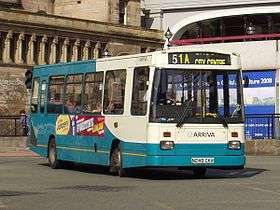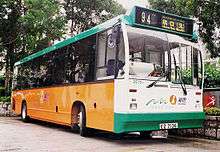Dennis Dart
| Dennis Dart/Dart SLF | |
|---|---|
_(cropped).jpg) Arriva Medway Towns Plaxton Pointer I bodied Dennis Dart SLF at Chatham Waterfront Bus Station in May 2013 | |
|
Arriva North West & Wales Plaxton Pointer bodied Dennis Dart Dennis Dart SLF interior | |
| Overview | |
| Manufacturer | Dennis/TransBus/Alexander Dennis |
| Production | 1989–2007 |
| Body and chassis | |
| Doors | 1 or 2 doors |
| Floor type | Step entrance/Low floor |
| Powertrain | |
| Engine |
Cummins B Series Cummins ISBe |
| Transmission |
Allison Eaton Voith |
| Dimensions | |
| Length |
Dart: 8.5m, 9.0m, 9.8m Dart SLF: 8.8m, 9.2m, 9.3m, 10.0m, 10.1m, 10.6m, 10.7m, 11.3m |
| Width | 2.4m or 2.5m |
| Chronology | |
| Successor | Alexander Dennis Enviro200 Dart |
The Dennis Dart is a rear-engined single-decker bus chassis manufactured by Dennis (later Alexander Dennis) in Guildford, England. More than 11,000 were produced during 18 years of production.
Most were purchased by United Kingdom operators, although examples were sold to America, Australia, Hong Kong and Singapore.
Standard-floor Dart
The Dennis Dart was conceived when Hestair Group (owner of Dennis and Duple) decided to produce a bus between a minibus and a full-sized single-decker.[1][2]
It was launched in 1988 and was originally offered with the Duple Dartline bodywork. It was 2.3m wide and was initially available in the length of 9m, but later available in lengths of 8.5m and 9.8m. It was powered by a Cummins 6BT engine and coupled to the Allison AT545 gearbox (the same engine and gearbox were also used in the MCW Metrorider, latterly the Optare MetroRider).
This model was sold to London Buses and to some operators outside London. Soon after it was launched, Duple was sold to Plaxton and the Blackpool plant closed. Plaxton decided not to acquire the design rights of the Duple Dartline and it was sold to Carlyle Works, who continued producing the bodywork from 1991. Production passed to Marshall of Cambridge in 1992 who bodied five Darts to this design. In 1993, Marshall updated the design to the C36 and later, the C37.
In 1990, Wadham Stringer became the next builder to body the Dart with a body called the Portsdown, but it was sold in small numbers and replaced by the UVG Urbanstar in 1995. In the same year, Wright bodied the Dart with the Handybus. In early 1991, Plaxton launched the Pointer (which was initially designated as Reeve Burgess Pointer as it was built at Reeve Burgess's plant, until later in the same year when it was transferred to Plaxton's Scarborough plant). Later in 1991, East Lancs bodied the Dart with its EL2000. In the latter half of 1991, Alexander launched the Dash. Another contender entering the market at the same time was the Northern Counties Paladin. Initially, it was built with a design of a barrel shaped windscreen with quarterlights (which were mainly sold to Warrington Borough Transport), later models had a deep double-curvature two-piece windscreen. It was phased out when Plaxton bought Northern Counties in 1995.
As the low floor buses became more popular in late 1990s, orders for standard-floor Dart dropped heavily and production ceased in 1998, with the final five delivered to Jersey Motor Transport.
Low-floor Dart SLF
.png)
In 1995, Dennis launched a low-floor version of the Dart, the Dennis Dart SLF (Super Low Floor), which later became known as the TransBus Dart/Alexander Dennis Dart.
It was 2.4m wide and initially offered in lengths of 9.2m, 10m and 10.6m, with air suspension introduced in place of the taper leaf used in the original design. The driveline of the step-entrance Dart was retained, although some early examples were fitted with Eaton manual transmission.
It was initially offered with the low floor version of the Pointer (which was notable for being wider), replaced by the updated Pointer 2 in 1997. It was also offered with a wide variety of bodies, namely the East Lancs Spryte, UVG Urbanstar (later renamed as the Caetano Compass; replaced by the Nimbus in 1999), the Wright Crusader, Alexander ALX200 (discontinued in 2001 with the formation of Transbus International and being replaced by the Pointer 2), Marshall Capital (developed from the C37; later built by MCV), Caetano Nimbus and MCV Evolution (since 2005 - a further evolution of the Marshall bodywork).

%2C_25_July_2008.jpg)
Some Dart SLFs with Alexander ALX200 bodies were delivered to North America and sold as Thomas Dennis SLF-series buses.
In 1997, the Dart SPD (Super Pointer Dart) was launched with the length of 11.3m (about the same length as a long Leyland National). It has a more powerful engine and a more heavy duty Allison World Series B300R gearbox, but also with an option of a Voith gearbox. Originally offered only with Plaxton Pointer 2 bodywork (hence the 'P' in the name) this larger bus was later offered with other bodywork such as East Lancs, the Alexander ALX200 and a few have also been bodied by Marshall. In 1998, it was accompanied by the MPD (Mini Pointer Dart) at 8.8m long, a model reminiscent of the original 8.5m Darts.
With the move to Euro III emissions in October 2001, the new Cummins ISBe engine was launched, with the 4-cylinder 3.9-litre model being used in all lengths except the 11.3m version, which uses the more powerful 6-cylinder, 5.9-litre version. The Cummins ISBe Euro IV engine became available on the Dart SLF chassis since late 2006.
In 2007 the Dennis Dart SLF was superseded by the Alexander Dennis Enviro200 Dart. The last Alexander Dennis Dart SLF was delivered to Park Island Transport, Hong Kong in March 2008.
Narrow width Dart SLF
A further variant of the Dart SLF appeared by 2002, when bus operators in the Channel Islands of Guernsey and then Jersey replaced the majority of their fleets with slightly narrower Darts designed to comply with the islands' vehicle size restrictions, sporting adapted versions of existing East Lancs and Caetano bodies respectively. Further examples have since joined them and small numbers of similar buses have entered service with other operators around the UK. Gibraltar also has a fleet of these narrower buses. The last ones entered service in summer 2007, but Alexander Dennis had not produced a direct replacement by September 2008.
Exports
Although primarily sold in the United Kingdom, some were sold overseas:
- Australia: ACTION (25),[3] Brisbane Bus Lines (3),[4] Invicta Bus Services (27)[5] and Transperth (2)[6]
- Hong Kong: New World First Bus (36)
- Singapore: Singapore Bus Service (10)[7]
Gallery


- Preserved Arriva London Northern Counties Paladin in April 2009
%2C_24_July_2008.jpg) Rossendale Transport Marshall C37 bodied Dennis Dart in July 2008
Rossendale Transport Marshall C37 bodied Dennis Dart in July 2008
- Preserved Southern Vectis Carlyle Works bodied Dennis Dart SLF in April 2011



_going_green_soon.jpg)
- Singapore Bus Service 1993 Duple bodied Dennis Dart in January 2009
 New World First Bus Carlyle Works bodied Dennis Dart in Hong Kong in August 2005
New World First Bus Carlyle Works bodied Dennis Dart in Hong Kong in August 2005
 Arriva Kent and Sussex Plaxton Pointer 1 bodied Dennis Dart SLF in a special livery for the centenary of Maidstone's buses in September 2004.
Arriva Kent and Sussex Plaxton Pointer 1 bodied Dennis Dart SLF in a special livery for the centenary of Maidstone's buses in September 2004.
See also
References
| Wikimedia Commons has media related to Dennis Dart. |
- ↑ DT, DC: The Duple / Carlyle Darts Ian's Bus Stop
- ↑ Dennis Dart: the first Generation Ian's Bus Stop
- ↑ Dennis Dart SLF Specifications ACT Bus Wiki
- ↑ Brisbane Bus Lines Australian Bus Fleet Lists
- ↑ Invicta Bus Services Australian Bus Fleet Lists
- ↑ Dennis Dart SLF Perth Bus Info
- ↑ Dennis Dart (Duple Metsec) SGBuses.com